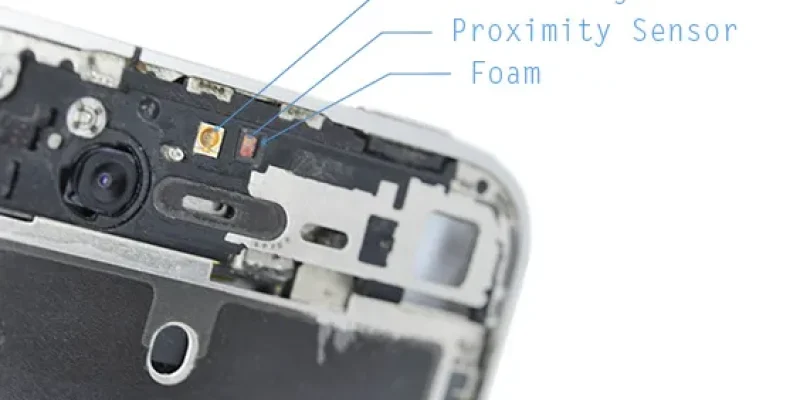I. Вступ до датчиків наближення в телефонах
A. Визначення датчиків наближення
Датчик наближення - це пристрій, який використовується в смартфонах для виявлення присутності об'єктів поблизу без фізичного контакту. Зазвичай він працює, випромінюючи електромагнітне поле або пучок електромагнітного випромінювання (наприклад, інфрачервоного) і вимірюючи зміни в полі або зворотний сигнал від об'єктів поблизу. У смартфонах ці датчики мають вирішальне значення для увімкнення різних функцій, які покращують користувацький досвід.
B. Базова функція в смартфонах
Основна функція датчика наближення в смартфонах - визначати, наскільки близько користувач знаходиться до пристрою. Ця можливість дозволяє датчику виконувати кілька ключових дій:
- Увімкнення/вимкнення екрану: Датчик автоматично вмикає екран, коли користувач дивиться на нього, і вимикає, коли телефон підносять близько до вуха під час розмови. Це запобігає випадковим дотикам, водночас гарантуючи, що дисплей буде доступним, коли це необхідно.
- Розпізнавання обличчя: Датчики наближення також сприяють технології розпізнавання обличчя, дозволяючи користувачам безпечно та зручно розблоковувати свої телефони.
- Економія заряду акумулятора: Вимикаючи дисплей, коли він не використовується, датчики наближення допомагають заощаджувати заряд акумулятора, сприяючи загальній енергоефективності.
II. Як працюють датчики наближення
Типи датчиків наближення, що використовуються в телефонах
- Інфрачервоні (ІЧ) датчики:
Інфрачервоні датчики наближення випромінюють інфрачервоне світло і визначають кількість світла, відбитого від сусідніх об'єктів. Коли об'єкт наближається, він або відбиває, або блокує інфрачервоне світло, що викликає реакцію датчика. Цей тип зазвичай використовується в смартфонах для вимкнення дисплея під час дзвінків, щоб запобігти випадковим дотикам.
- Ємнісні датчики:
Ємнісні датчики наближення працюють за рахунок виявлення змін ємності, спричинених присутністю об'єкта. Вони складаються з двох провідних пластин, розділених діелектриком. Коли об'єкт потрапляє в електричне поле датчика, він змінює ємність між пластинами, що активує датчик. Ці датчики можуть виявляти як провідні, так і непровідні матеріали, що робить їх універсальними для різних застосувань у смартфонах.
Принципи роботи
Датчики наближення функціонують, випромінюючи сигнал і вимірюючи реакцію від об'єктів, що знаходяться поблизу. Принципи роботи залежать від типу датчика:
- Інфрачервоні датчики: Ці датчики випромінюють інфрачервоне світло і вимірюють, скільки світла відбивається назад, щоб визначити, чи знаходиться об'єкт поблизу. Зміна відбитого інфрачервоного світла вказує на близькість, дозволяючи телефону реагувати відповідно, наприклад, вимкнути екран під час дзвінка.
- Ємнісні датчики: Ємнісні датчики працюють, створюючи навколо себе електричне поле. Коли провідний або непровідний об'єкт потрапляє в це поле, він змінює ємність, виявлену датчиком. Ця зміна викликає відповідну реакцію, наприклад, вимкнення дисплея або активацію інших функцій смартфона.
III. Мета та застосування
A. Запобігання випадковим дотикам під час дзвінків
Одне з основних призначень датчиків наближення в смартфонах - запобігати випадковим дотикам під час телефонних дзвінків. Коли користувач підносить телефон до вуха, датчик наближення виявляє це і автоматично вимикає дисплей. Ця функція гарантує, що обличчя користувача ненавмисно не активує кнопки або функції, що може призвести до збоїв під час розмови, наприклад, вимкнути звук або покласти слухавку.
B. Енергозбереження шляхом вимкнення екрана
Датчики наближення відіграють важливу роль в енергозбереженні, вимикаючи екран, коли він не використовується. Автоматично вимикаючи дисплей, коли телефон підноситься до тіла користувача (наприклад, під час дзвінка), ці датчики допомагають заощадити заряд акумулятора. Таке автоматичне затемнення або вимкнення екрану зменшує споживання енергії, сприяючи підвищенню загальної ефективності пристрою.
C. Інші додатки в смартфонах
Окрім запобігання випадковим дотикам та економії заряду акумулятора, датчики наближення мають ще кілька застосувань у смартфонах:
- Розпізнавання обличчя: Датчики наближення допомагають у технології розпізнавання обличчя, забезпечуючи безпечне та зручне розблокування пристроїв. Визначаючи, коли користувач дивиться на свій телефон, він може активувати камеру для розпізнавання обличчя.
- Автоматична активація екрану: Ці датчики також можуть активувати екран, коли користувач піднімає телефон або наближається до нього, забезпечуючи швидкий доступ до сповіщень і додатків без необхідності натискання будь-яких кнопок.
- Безконтактна взаємодія: Деякі смартфони використовують датчики наближення для безконтактної взаємодії, що дозволяє користувачам керувати певними функціями (наприклад, прокруткою або навігацією) без фізичного контакту, підвищуючи зручність використання та гігієнічність.
IV. Технічні характеристики
A. Діапазон виявлення
Дальність виявлення датчиків наближення варіюється залежно від типу датчика. Загалом, дальність виявлення можна класифікувати наступним чином:
- Інфрачервоні (ІЧ) датчики: Зазвичай мають діапазон виявлення від 1 до 10 сантиметрів, що робить їх придатними для застосування на близьких відстанях, наприклад, для телефонних дзвінків.
- Ємнісні датчики: Ці датчики можуть виявляти об'єкти на відстані приблизно від 1 до 5 сантиметрів, залежно від діелектричних властивостей об'єкта, що виявляється. Їх чутливість дозволяє виявляти як провідні, так і непровідні матеріали.
B. Час відгуку
Датчики наближення відомі своїм швидким часом відгуку, що є важливим для застосувань, які потребують негайного зворотного зв'язку. Час відгуку може варіюватися, але зазвичай він знаходиться в межах:
- Інфрачервоні датчики: Час відгуку може становити лише кілька мілісекунд, що дозволяє майже миттєво активувати або деактивувати такі функції, як затемнення екрана під час дзвінків.
- Ємнісні датчики: Ці датчики також демонструють швидкий час відгуку, зазвичай протягом декількох мілісекунд, забезпечуючи безперебійну взаємодію з користувачем.
C. Енергоспоживання
Енергоспоживання є критичним фактором для мобільних пристроїв, а датчики наближення розроблені таким чином, щоб бути енергоефективними:
- Інфрачервоні датчики: Зазвичай споживають мало енергії, коли активні, і можуть переходити в сплячий режим, коли не використовуються, що додатково заощаджує час роботи акумулятора.
- Ємнісні датчики: Аналогічно, ці датчики розроблені для роботи з мінімальним енергоспоживанням, часто використовуючи менше енергії, ніж традиційні механічні перемикачі.
V. Інтеграція з іншими компонентами телефону
A. Взаємодія з дисплеєм
Датчики наближення є невід'ємною частиною взаємодії з дисплеєм смартфонів. Коли користувач телефонує і підносить телефон до вуха, датчик наближення виявляє цей рух і автоматично вимикає дисплей. Це запобігає випадковим дотикам, які можуть перервати дзвінок, наприклад, вимкнути звук або ненавмисно покласти слухавку. Датчик працює, аналізуючи інфрачервоне світло, що випромінюється пристроєм, і вимірюючи відбиття від розташованих поруч об'єктів, гарантуючи, що екран залишається вимкненим, коли він не потрібен. Крім того, коли телефон віддаляється від вуха, датчик знову активує дисплей, дозволяючи користувачам легко отримувати доступ до сповіщень та інших функцій без необхідності натискання кнопок.
B. Координація з операційною системою телефону
Координація з операційною системою телефону має вирішальне значення для максимізації функціональності датчиків наближення. Операційна система інтерпретує сигнали від датчика наближення для ефективного керування різними функціями. Наприклад, коли користувач підносить телефон до обличчя, операційна система може використовувати дані з датчика наближення, щоб увімкнути дисплей або активувати функції розпізнавання обличчя.
Крім того, впроваджено вдосконалені алгоритми для встановлення порогових значень для активації або деактивації функцій на основі зчитування даних про наближення. Це допомагає мінімізувати помилкові спрацьовування, наприклад, вимкнення екрану, коли користувач закриває його рукою замість того, щоб піднести до обличчя. Інтеграція також дозволяє налаштовувати функції на основі факторів навколишнього середовища, таких як умови навколишнього освітлення, що покращує продуктивність у різних сценаріях.
VI. Досягнення в технології датчиків наближення
A. Підвищена точність і надійність
За останні роки технологія датчиків наближення зазнала значного прогресу, що призвело до підвищення точності та надійності. Виробники розробили нові конструкції датчиків і матеріали, які забезпечують вищу роздільну здатність і точність. Наприклад, прогрес у мініатюризації датчиків призвів до створення компактних індуктивних і ємнісних датчиків, які забезпечують більш точні результати, особливо в таких галузях, як виробництво напівпровідників, що значною мірою покладаються на точність.
Крім того, інтеграція штучного інтелекту (ШІ) і машинного навчання в датчики наближення дозволяє краще прогнозувати і реагувати на зміни у виробничому середовищі. Така оптимізація автоматизованих систем призводить до підвищення точності та надійності датчиків наближення.
B. Інтеграція з іншими датчиками
Датчики наближення все частіше інтегруються з іншими типами датчиків для отримання більш повних і точних даних. Одним з яскравих прикладів є інтеграція датчиків наближення з датчиками освітленості (ALS) у смартфонах.
Поєднуючи датчики наближення та навколишнього освітлення, смартфони можуть автоматично регулювати яскравість дисплея залежно від наближення користувача до пристрою та умов навколишнього освітлення. Ця інтеграція покращує користувацький досвід, забезпечуючи оптимальну видимість і водночас заощаджуючи заряд акумулятора.
Крім того, інтеграція датчиків наближення з іншими датчиками, такими як акселерометри та гіроскопи, уможливлює розширені функції, такі як розпізнавання жестів. Це дозволяє користувачам керувати певними функціями своїх пристроїв без фізичного дотику до екрану, що ще більше підвищує зручність використання та гігієнічність.


